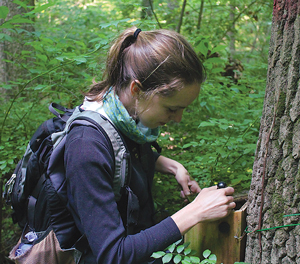Does invasive plant raise risk of Lyme?

RESEARCH | A doctoral student in entomology and wildlife ecology is working to identify important ecological factors that contribute to Lyme disease infections in Delaware, which has one of the nation’s highest per-capita rates of the disease.
Solny Adalsteinsson is conducting her research in a group of forest fragments around New Castle County, Delaware, sampling ticks, mice and birds to determine factors in those areas that influence tick-borne disease transmission and human disease risk.
When it comes to mice and the rate at which they transmit tick-borne diseases, Adalsteinsson points to a possible culprit—the invasive multiflora rose plant, which takes over an area and covers it in a dense thicket. Ticks are sensitive to drying out, and such a cover provides them with high humidity and stable temperatures. It’s an attractive environment for mice, as well, she says, providing them with good cover from predators.
Adalsteinsson is also looking at birds, particularly how the influx of migratory birds during each breeding season affects the disease transmission cycle. To do this, she is netting birds across the forest fragments “to see if we can identify movement patterns that might explain how ticks are being moved across this type of landscape,” she says.





